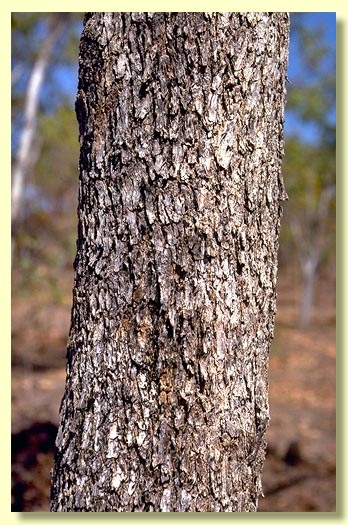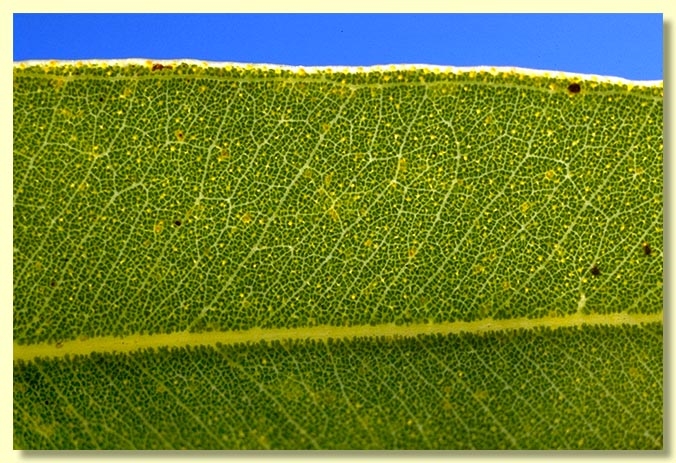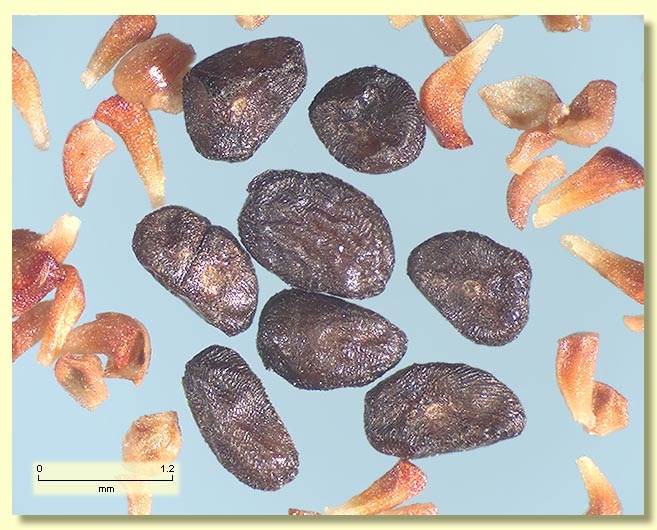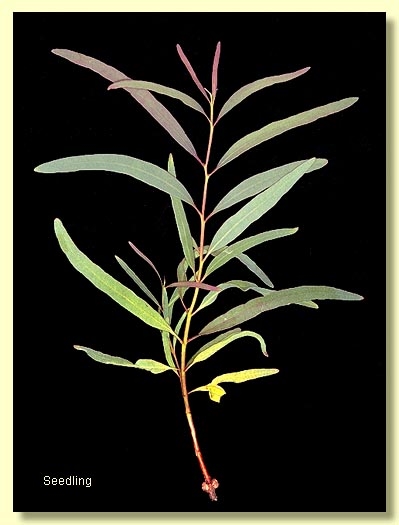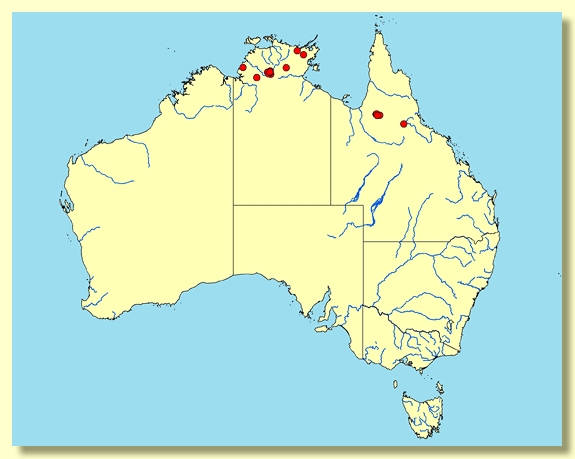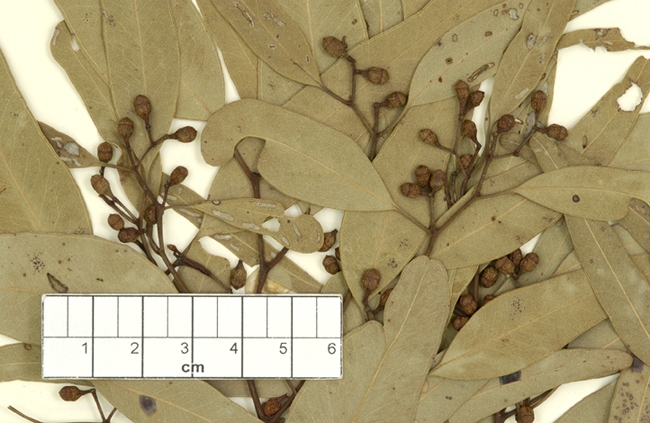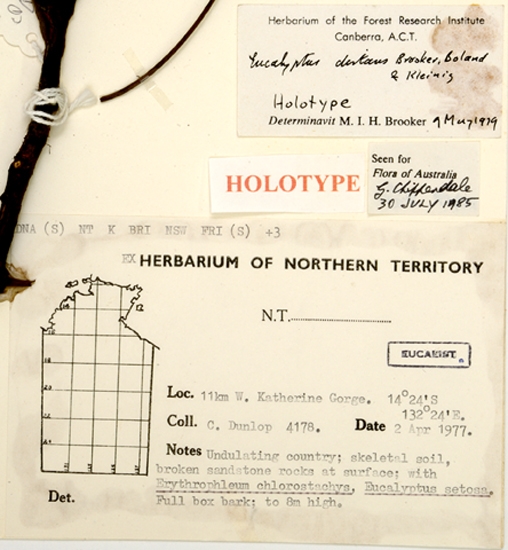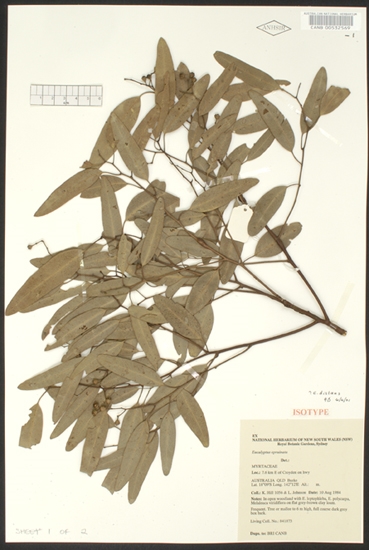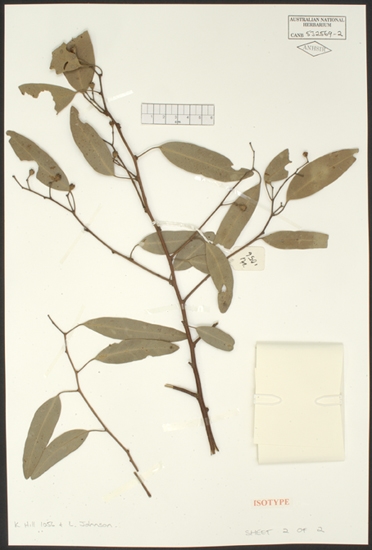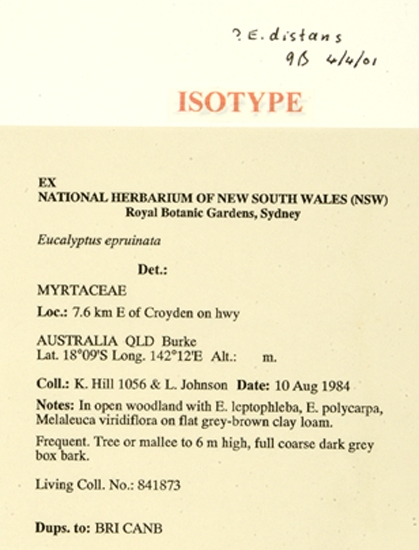Eucalyptus | Symphyomyrtus | Adnataria | Apicales | Aquilonares | Protrusae
Euclid - Online edition
Eucalyptus distans
Eucalyptus epruinata L.A.S. Johnson & K.D. Hill, Telopea 8 (4) 530 (2000). T: Queensland: 7.6 km E of Croydon on Georgetown road, 18° 09' S, 142° 12' E, K.D.Hill 1056 & L.A.S.Johnson, 10 Aug 1984; holo: NSW; iso: BRI, CANB, K.
Tree to 7 m tall. Forming a lignotuber.
Bark rough throughout, box-type, finely fissured, grey to whitish grey.
Branchlets lacking oil glands in the pith; non-glaucous.
Juvenile growth (coppice or field seedlings to 50 cm): stems rounded to square in cross-section; juvenile leaves always petiolate, alternate, narrowly lanceolate, 11–14 cm long, 1–2 cm wide, green.
Adult leaves thin-textured, alternate, petioles 0.5–2.3 cm long; blade usually lanceolate, sometimes falcate, (5.5)7–15 cm long, 1.2–2.6 cm wide, base tapering to petiole, apex rounded to pointed, margin entire, concolorous, dull, light green to grey-green, side-veins acute or greater than 45° to midrib, reticulation very dense, intramarginal vein present, oil glands scattered, intersectional.
Inflorescence terminal compound, peduncles slender and more or less angular, 0.2–1 cm long, buds 7 per umbel, pedicels (0)0.2–0.6 cm long. Mature buds shortly cylindrical to ovoid, 0.3–0.4 cm long, ca 0.3 cm wide, scar present (outer operculum shed early), operculum conical to rounded and apiculate, stamens irregularly flexed, all fertile, anthers adnate, more or less cuboid, dehiscing by lateral slits, style straight, long, stigma blunt, locules 4, the placentae each with 4 vertical ovule rows. Flowers creamy white.
Fruit pedicellate (pedicels (0)0.2–0.6 cm long), cupular to hemispherical or more or less obconical, 0.3–0.5 cm long, 0.3–0.5 cm wide, disc narrow, annular, level or obliquely descending, valves 4, strongly exserted.
Seeds blackish brown, 1–2 mm long, flattened-ovoid, sometimes pointed at one end, dorsal surface shallowly reticulate, hilum ventral.
Cultivated seedlings (measured at ca node 10): cotyledons small, reniform; stems rounded to square in cross-section; leaves always petiolate, opposite for 6 to 10 nodes then becoming alternate, linear to lanceolate, 5.5–10 cm long, (0.3)0.6–1 cm long, base tapering, apex pointed, dull, green, concolorous.
Flowering has been recorded in March and April.
A small tree from the Top End of the Northern Territory where it occurs sporadically from near Katherine to near Gove, and also from North Queensland, where a disjunct population occurs in the Croydon area. (This population was described as E. epruinata by Hill & Johnson (2000) but this is regarded by the authors of EUCLID as the same as E. distans.) E. distans has rough grey-white box-type bark to the small branches, a dull green-leaved crown and small fruit with exserted valves and a level to slightly descending disc.
Eucalyptus distans belongs in Eucalyptus subgenus Symphyomyrtus section Adnataria (the boxes) because the buds have two opercula, ovules are in four rows, seeds are flattened-ovoid, cotyledons are reniform, and anthers are rigid on the staminal filaments. Within section Adnataria, E. distans is part of a subgroup of box species with mostly tropical distribution, series Aquilonares subseries Protrusae, having inflorescences terminal on the branchlets, adult leaves very densely reticulate and fruit that are small, fragile and have exserted valves.
Within subseries Protrusae E. distans is closest to E. obconica. Both have relatively small fruit. E. obconica, from the Kimberley region of Western Australia, differs by having sessile buds and fruit and narrow lanceolate juvenile leaves.
E. distans has historically been confused with E. microtheca but differs from that species in the fruit characters mentioned and in its preferred habitat on low stony ridges. E. microtheca has fruit with a narrow vertically descending disc and valves at rim level or scarcely exserted, and prefers seasonally wet sites with heavier soils on floodplains near creeks.
Two other tropical boxes which maybe confused with E. distans are E. argillacea and E. tectifica. E. argillacea, from the Kimberley, differs by having glaucous buds and fruit. E. tectifica differs by having thin walled fruit that are normally wider than those in E. distans and also has valves near the rim or only slightly exserted.
In Queensland, it may also be confused with E. microneura or E. leucophylla. E. microneura has glaucous buds and glaucous obconical fruit. E. leucophylla has slightly bigger fruit (0.5–0.7 cm) and valves that are at rim level or slightly exserted.
Eucalyptus distans: Latin distans, standing apart, indicating that this species is both taxonomically and in habitat preference separated from E. microtheca, with which it was previously confused.


